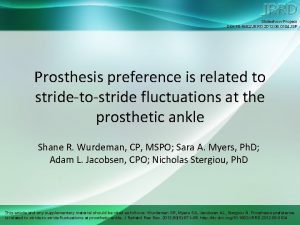Slideshow Project DOI 10 1682JRRD 2012 06 0104





- Slides: 5

Slideshow Project DOI: 10. 1682/JRRD. 2012. 06. 0104 JSP Prosthesis preference is related to stride-to-stride fluctuations at the prosthetic ankle Shane R. Wurdeman, CP, MSPO; Sara A. Myers, Ph. D; Adam L. Jacobsen, CPO; Nicholas Stergiou, Ph. D This article and any supplementary material should be cited as follows: Wurdeman SR, Myers SA, Jacobsen AL, Stergiou N. Prosthesis preference is related to stride-to-stride fluctuations at prosthetic ankle. J Rehabil Res Dev. 2013; 50(5): 671– 86. http: //dx. doi. org/10. 1682/JRRD. 2012. 06. 0104

Slideshow Project DOI: 10. 1682/JRRD. 2012. 06. 0104 JSP • Aim – Determine relationship between stride-to-stride fluctuations and prosthesis preference. • Relevance – Stride-to-stride fluctuations in gait cycle may better quantify neuromuscular control related to prosthesis preference. This article and any supplementary material should be cited as follows: Wurdeman SR, Myers SA, Jacobsen AL, Stergiou N. Prosthesis preference is related to stride-to-stride fluctuations at prosthetic ankle. J Rehabil Res Dev. 2013; 50(5): 671– 86. http: //dx. doi. org/10. 1682/JRRD. 2012. 06. 0104

Method Slideshow Project DOI: 10. 1682/JRRD. 2012. 06. 0104 JSP • 13 people with unilateral transtibial amputation walked on treadmill for 3 min with their prescribed an alternate prosthesis. • Stride-to-stride fluctuations were quantified with largest Lyapunov exponent (Ly. E) of each joint flexion/extension time series. – Change in Ly. E was calculated for each major lowerlimb joint for both conditions. • Participants indicated preference between prostheses on continuous visual analog scale. This article and any supplementary material should be cited as follows: Wurdeman SR, Myers SA, Jacobsen AL, Stergiou N. Prosthesis preference is related to stride-to-stride fluctuations at prosthetic ankle. J Rehabil Res Dev. 2013; 50(5): 671– 86. http: //dx. doi. org/10. 1682/JRRD. 2012. 06. 0104

Results Slideshow Project DOI: 10. 1682/JRRD. 2012. 06. 0104 JSP • Change in Ly. E: – Correlated with degree of preference between prostheses at prosthetic ankle. • Change in Ly. E of prosthetic ankle: – Strongly related to degree of preference (r = 0. 629, p = 0. 02). This article and any supplementary material should be cited as follows: Wurdeman SR, Myers SA, Jacobsen AL, Stergiou N. Prosthesis preference is related to stride-to-stride fluctuations at prosthetic ankle. J Rehabil Res Dev. 2013; 50(5): 671– 86. http: //dx. doi. org/10. 1682/JRRD. 2012. 06. 0104

Conclusion Slideshow Project DOI: 10. 1682/JRRD. 2012. 06. 0104 JSP • Stride-to-stride fluctuations, quantified by Ly. E, are strongly related to patient’s perception of prosthesis. • Thus, Ly. E is first objective measure to detect changes in gait that relate to patient’s perception of prosthesis. • Ly. E should be further examined as potentially effective prescriptive and outcome measure in prosthetic rehabilitation. This article and any supplementary material should be cited as follows: Wurdeman SR, Myers SA, Jacobsen AL, Stergiou N. Prosthesis preference is related to stride-to-stride fluctuations at prosthetic ankle. J Rehabil Res Dev. 2013; 50(5): 671– 86. http: //dx. doi. org/10. 1682/JRRD. 2012. 06. 0104









